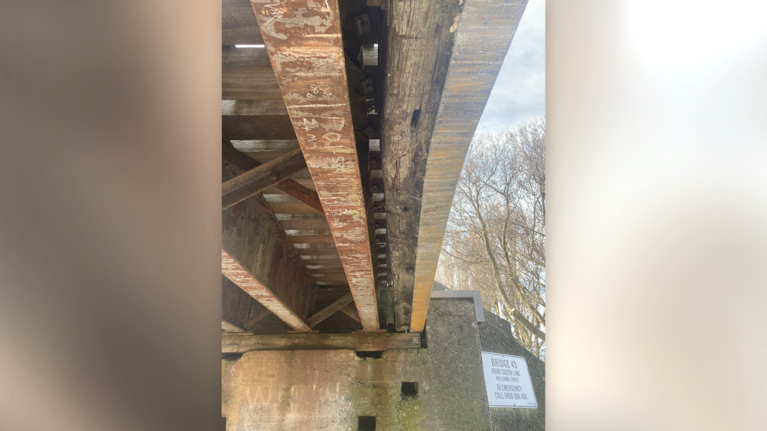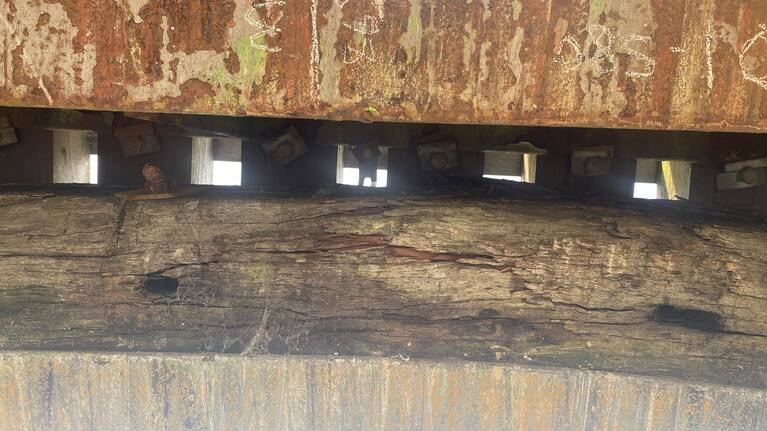Ashburton is home to New Zealand’s most hit bridge, the Tinwald Viaduct.
The short strip of road goes under the main south railway line, just south of the Hakatere/Ashburton River bridge, with a maximum clearance height of 2.39m high.
KiwiRail confirmed it was the most struck bridge in the country, with 13 known strikes per year. Currently, it is closed to vehicles while it awaits repairs after being hit by an excavator being towed on a trailer in early July.
The viaduct reopened following the bridge strike, but was temporarily closed on July 29.
Many agreed that the cheapest solution to stop it from being hit would be to close it to traffic permanently. The road under the viaduct was a local road under the jurisdiction of the Ashburton District Council.
The council’s infrastructure and open spaces manager Neil McCann said the decision to close the viaduct was made with KiwiRail and they intended to reopen the road once it was repaired.
What’s the damage?
KiwiRail chief infrastructure officer Siva Sivapakkiam confirmed the closure was to avoid the bridge being struck again and avoid disruption on the Main South Line.
“Damage was caused to the overhead impact beam, which protects the structural elements of the bridge, and there is damage to the primary structure, which is now susceptible to additional strikes.
“This leaves the bridge vulnerable to future undocumented strikes, which could pose a threat to the safety of rail and nearby road users.
“With the road now closed, we can safely investigate temporary measures to reinstate the collision protection beam while permanent replacement and repair is considered.”

Sivapakkiam confirmed that just days after the viaduct had been damaged, the bridge was struck again from the other side by a motorhome.
He said the Tinwald Viaduct was the most struck bridge in the country.
“There have been 13 documented bridge strikes per year in the last two years.”
That’s at least one per month, but it was just the documented ones, with locals claiming the viaduct was hit more often than authorities knew about.
In 2023, long-time resident Kevin Donaldson told Local Democracy Reporting it’s hit or there was a near miss at least once a week. It had now been struck to the point of needing repairs, which KiwiRail initially said could take six to eight months.
Sivapakkiam said the timeframe was dependent on a full assessment of the damage.
The assessment of the damage spans has been completed.
Design engineers were working on a solution to upgrade the impact beams and were considering replacements for the spans, Sivapakkiam said.

“KiwiRail will initially seek damages and repair costs through its internal recovery team, working with the owner of the vehicle involved in the bridge accident.
Estimated costs wouldn’t be known until designs were completed.
Sivapakkiam did not answer whether additional preventative measures were required or who would fund them.
Asked if the most effective measure to stop the repeated bridge strikes was a permanent closure, he said, “any decision on closing the road would have to be made by the council”.
Locals want access assurances
The threat of a permanent closure is why Tinwald resident Adam Kibblewhite penned an open letter to the council and KiwiRail.
In his letter, he stated, “there’s growing concern in the community that this temporary closure could become permanent”.
He has since received assurance from the council that the viaduct would reopen when the repair work was done.
From the feedback to his open letter, he was aware plenty of people supported a closure.
“I believe that is probably the cheapest option.
“The sad realisation was that most people wanting it closed just didn’t like people cutting down Melcombe Street and getting ahead of them in traffic.”
He said closing the viaduct after money had recently been spent upgrading it “would be foolish”.
Kibblewhite was against a permanent closure, but said he is open to the viaduct becoming left out only.
“I’m not overly excited by the idea, but weighing up all the options, it makes the most sense.”
The issue is not the bridge itself, but the repeated damage caused by over-height vehicles — a problem that’s been ongoing for years, he said.
Finding ways to reduce the number of bridge strikes is preferred to closing it, he said.
He believes a gantry (a structure designed to restrict the height of vehicles) is necessary on the western side of the viaduct and earlier height warning signage further down Melcombe Street.
Kibblewhite still remains critical of the proposed timeframe to replace the “sacrificial wooden beam”.
The fact the bridge remained in use by trains confirms its structural integrity is not compromised, “so it’s not an engineering issue,” he said.
Viaduct access options
During the Tinwald corridor improvements project, which focused on new traffic signals at the SH1/Lagmhor Road/Agnes St intersection, it had been initially proposed to restrict vehicle movements to ‘left turn only’ onto SH1, stopping traffic from turning into the viaduct or turning right from the highway.
It also added a dedicated cycle lane in the viaduct.
After consultation with the community and further investigations, NZTA decided in late 2022 “to retain full access at the viaduct with monitoring”.
NZTA system manager Mark Pinner said that monitoring had focused on vehicle safety when turning onto the state highway, and when turning into the viaduct from the state highway, as this was identified as a safety concern.
He said there has only been a single non-injury crash recorded at this intersection in the NZTA system.
“Currently, there are no plans to modify the intersection”.
The TinwaldCcrridor improvements were completed around 18 months ago and included enlarged clearance signage to improve visibility, he said.
As a local road under the council’s jurisdiction, and if roading changes are proposed, NZTA and council would need to work through the process, including consultation.
No plan to close
The council’s intention is to reopen the road when the work is complete.
McCann said there hasn’t been any further discussion on making it one-way only.
The viaduct’s temporary closure was raised at the council’s activity briefing on July 30.
Roading manager Mark Chamberlain said that, as it’s critical the main south rail line remains open, KiwiRail had requested the temporary closure of the viaduct “to take away that risk of getting hit” and possibly impacting the rail line.
“The only way of stopping it getting hit, as far as I can see, is not having vehicles going through it.
“You can put all the signage you like, someone will still hit it at some stage,” Chamberlain said.
Councillor Phill Hooper asked about the possibility of installing additional preventive measures, specifically a chain gantry either side of the viaduct.
Chamberlain said it came down to cost, practicality, and who pays for it.
Mayor Neil Brown said it would be cheaper for KiwiRail “to put in preventative devices than have the bridge hit all the time”.
Chamberlain said in terms of preventative measures, there is an argument that the cheapest thing is to close the road.
Alternative measures
There have been some previous investigations into installing a gantry over each approach a few years ago, McCann confirmed.
“This was not considered feasible because of the span over the traffic lanes, the strength of the structure to withstand weather events, the space available before the bridge, and the issue of vehicles reversing into traffic.”
The cost then was in the order of $20,000 per gantry, but that estimate was based on the concept rather than a design he said.
“I suspect it would cost more than that and there would also be the maintenance as the structure will no doubt be hit at some stage along with weathering.
“We are currently making enquiries on an electronic warning for vehicles, but have no information yet.
“We will discuss costs with KiwiRail, however, generally costs of signage on the approaches to level crossings are a cost to council.”
The history
An excerpt from Tinwald: A Canterbury Plains Settlement by Emily Bayliss explains how the Tinwald subway was built.
The land at the river end of Melcombe St was originally part of the Lagmhor Estate.
When the railway went through the town, the access to the estate was over the railway line further south.
When George A M Buckley wanted to subdivide the estate, he considered that the land nearer the river would sell more readily with easier access.
A new access point required the approval and co-operation of the Tinwald Town Board and the Railways Department.
The Town Board considered the request in February 1899, deciding to investigate if a level crossing or subway would be better.
A subway was decided on, and plans were approved by the Railway Department.
Local Democracy Reporting is local body journalism co-funded by RNZ and NZ On Air











